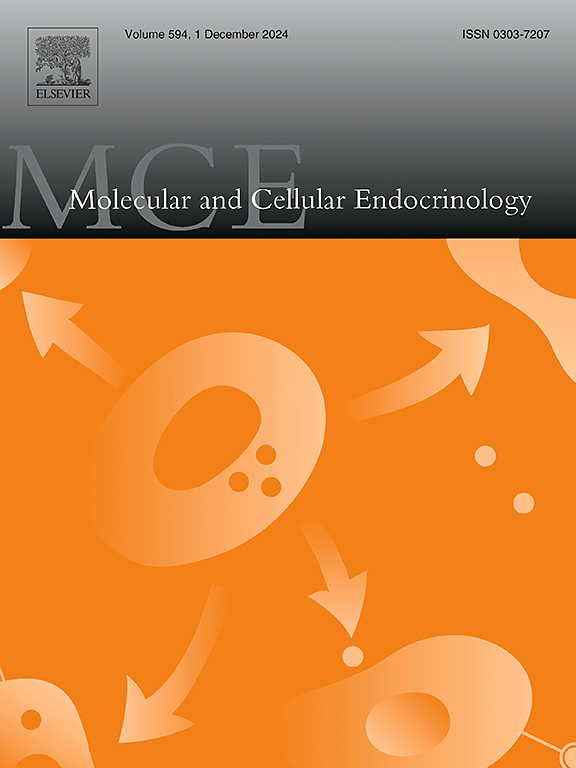Inhibiting the fructose transporter GLUT5 boosts testosterone production in a murine mLTC-1 leydig cell line
IF 3.6
3区 医学
Q2 CELL BIOLOGY
引用次数: 0
Abstract
Over the past few decades, a significant change globally in sugar intake has coincided with a rising incidence of male infertility, which is now a major public health concern. Diets rich in fructose have been implicated in both male infertility and increased susceptibility to metabolic disorders, such as obesity, diabetes, and related heart problems. While fructose is known to be present in seminal fluid and crucial for sperm motility, the precise role of fructose in testicular function remains largely unknown.
GLUT5 is an exclusive fructose transporter essential for dietary fructose uptake in the intestine. It is also expressed mainly in germ and Leydig cells. We recently revealed that disrupting the Glut5 gene in male mice impairs spermatogenesis and steroidogenesis. However, its specific role within Leydig cells remains unexplored. Therefore, we investigated its role by inhibiting GLUT5 in a murine Leydig cell line (mLTC-1) using a specific inhibitor of GLUT5, MSNBA, combined with a multi-omics approach.
Exposing mLTC-1 cells to MSNBA reduced the intracellular fructose content, limited cell proliferation, and enhanced progesterone and androgens production (Δ4-androstenedione and testosterone). The latter was associated with the upregulation of two genes and proteins involved in steroidogenesis, such as Hsd3b and steroidogenic acute regulatory protein (StAR). GLUT5 inhibition in mLTC-1 cells also modified lipid and carbohydrate metabolism. Lipidomic analysis showed decreased cholesterol esters and a shift in the ratio of polyunsaturated fatty acids (PUFAs) to monounsaturated fatty acids (MUFAs). These lipid changes correlated with alterations in the expression of mRNA-encoding enzymes involved in lipogenesis, such as ELOVL6. Metabolomics analysis showed a reduction in most glycolysis metabolites, except for pyruvate and lactate. However, pyruvate could conserve its level by a production through an amino acid pathway using the higher branched-chain amino acid content. Nevertheless, the activity of mitochondria measured by seahorse was not altered. The transcriptomic analysis performed by BRB-seq approach revealed an upregulation of several androgen-sensitive genes, such as Akap5, Slc39a9, an androgen receptor or lactate dehydrogenase A (Ldha), which produces lactate, and downregulation of several genes associated with the insulin pathway such as Tsc2 or the hexokinase Hkdc1.
In conclusion, GLUT5 supported fructose intake in the murine Leydig cell line mLTC-1, leading to a reduction in cell proliferation. The consequences of inhibition of GLUT5 led to an increase in fatty acids cell content, a perturbation in glycolysis and amino-acid metabolism but an enhanced androgen production. Since androgens regulate spermatogenesis, hyperandrogenism induced by a lower fructose content in Leydig cells may be a primary cause leading to the disruption of sperm production and quality, as well as sexual behavior, as described in the GLUT5 KO mouse model.
抑制果糖转运体GLUT5可促进小鼠mLTC-1间质细胞系中睾酮的产生。
在过去的几十年里,全球糖摄入量的重大变化与男性不育症发病率的上升同时发生,这现在是一个主要的公共卫生问题。富含果糖的饮食与男性不育和易患代谢紊乱(如肥胖、糖尿病和相关心脏问题)有关。虽然果糖已知存在于精液中,对精子活力至关重要,但果糖在睾丸功能中的确切作用在很大程度上仍然未知。GLUT5是肠道摄取膳食果糖所必需的唯一果糖转运蛋白。它也主要在胚芽细胞和间质细胞中表达。我们最近发现,破坏雄性小鼠的Glut5基因会损害精子发生和类固醇发生。然而,它在间质细胞中的具体作用仍未被探索。因此,我们通过使用GLUT5特异性抑制剂MSNBA结合多组学方法,在小鼠间质细胞系(mLTC-1)中抑制GLUT5来研究其作用。将mLTC-1细胞暴露于MSNBA可降低细胞内果糖含量,限制细胞增殖,并增强孕酮和雄激素的产生(Δ4-androstenedione和睾酮)。后者与两种参与类固醇生成的基因和蛋白的上调有关,如Hsd3b和类固醇生成急性调节蛋白(StAR)。mLTC-1细胞中GLUT5的抑制也改变了脂质和碳水化合物代谢。脂质组学分析显示胆固醇酯降低,多不饱和脂肪酸(PUFAs)与单不饱和脂肪酸(MUFAs)的比例发生了变化。这些脂质变化与参与脂肪生成的mrna编码酶(如ELOVL6)表达的改变相关。代谢组学分析显示,除了丙酮酸和乳酸外,大多数糖酵解代谢物都减少了。然而,丙酮酸可以通过氨基酸途径利用较高的支链氨基酸含量来保持其水平。然而,海马测定的线粒体活性并没有改变。通过BRB-seq方法进行的转录组学分析显示,几个雄激素敏感基因(如Akap5, Slc39a9,雄激素受体或乳酸脱氢酶A(乳酸))上调,几个与胰岛素途径相关的基因(如Tsc2或己糖激酶Hkdc1)下调。总之,GLUT5支持小鼠间质细胞系mLTC-1的果糖摄入,导致细胞增殖减少。抑制GLUT5的结果导致脂肪酸细胞含量增加,糖酵解和氨基酸代谢紊乱,但雄激素产生增强。由于雄激素调节精子发生,因此,正如GLUT5 KO小鼠模型所描述的那样,由间质细胞中较低果糖含量诱导的高雄激素症可能是导致精子产生和质量以及性行为中断的主要原因。
本文章由计算机程序翻译,如有差异,请以英文原文为准。
求助全文
约1分钟内获得全文
求助全文
来源期刊

Molecular and Cellular Endocrinology
医学-内分泌学与代谢
CiteScore
9.00
自引率
2.40%
发文量
174
审稿时长
42 days
期刊介绍:
Molecular and Cellular Endocrinology was established in 1974 to meet the demand for integrated publication on all aspects related to the genetic and biochemical effects, synthesis and secretions of extracellular signals (hormones, neurotransmitters, etc.) and to the understanding of cellular regulatory mechanisms involved in hormonal control.
 求助内容:
求助内容: 应助结果提醒方式:
应助结果提醒方式:


